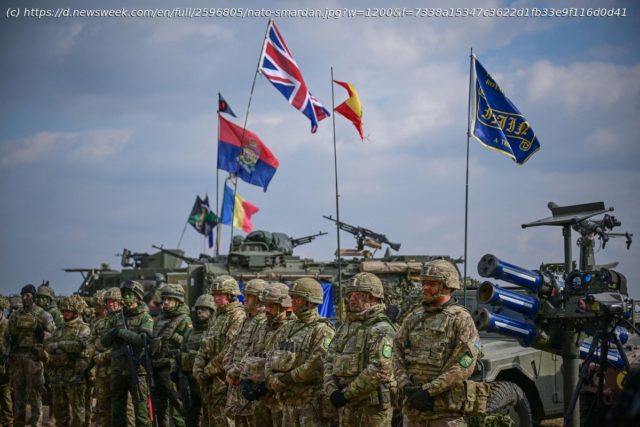Europe would be “very vulnerable” without U.S. support, said Ed Arnold, a senior research fellow at Britain’s Royal United Services Institute defense think tank.
The winter bitterness of Romania’s steppe was not the only chill as NATO soldiers exercised just miles from Ukraine last month.
There were no U.S. forces taking part in NATO’s biggest exercises this year. This may have always been the plan, but European nations going it alone on Ukraine’s doorstep took on a fresh significance as U.S. President Donald Trump and his administration rewrote Washington’s relationship with the continent.
The Steadfast Dart drills at the southeastern training ground of Smârdan throughout February were designed to show how a British-led multinational force could operate in a crisis. Aircraft struck mock enemy targets, tanks blasted live shells, soldiers wiggled their way through a frozen trench network and a bagpiper emerged from a smoke screen to waiting cameras.
But Trump’s pullback has shaken European nations badly and raised questions over how the continent could defend itself in a real crisis without the U.S. backing that has protected much of Europe from the potential Russian threat since the end of World War II.
Decades of sidelining defense spending after the end of the Cold War has allowed European countries to maintain prized social welfare systems, but has also left them with yawning capability gaps on defense and a deep reliance on the U.S. that has become increasingly unpalatable to the White House. There is no shying away from this from European officials, nor a desire to—there is a universal acceptance, privately and publicly, that the continent has been lamentably lax.
Despite alarm bells ringing for years, and even more loudly since Russia’s invasion of Ukraine in 2022, the continent’s leaders have still struggled to summon the political clout to significantly boost military spending. For most Western European members, the threat is geographically too far away—it is hard to make a convincing case to budget more for militaries when that could mean cuts to sectors such as health care, or further tax increases in what are already some of the world’s most heavily taxed countries.
Young people living far from the frontline states of NATO’s eastern flank with Russia show little appetite to serve in the military, let alone fight a war in defense of the continent.’Very Vulnerable’
Despite recent talk of a united European Army, even if European states do find the money and personnel, there is a question over how they could work together to coordinate everything from defense procurement to battlefield operations in a way that would allow them to field an effective fighting force.
At the drills, commanders would frequently say the different nations worked together slickly, taking the best parts of each country’s military forces. Lower-ranking soldiers, however, spoke of challenges at basic levels such as language skills.
“Very vulnerable” is how Europe would be without U.S. support, Ed Arnold, a senior research fellow at Britain’s Royal United Services Institute (RUSI) defense think tank, told Newsweek.
The war in Ukraine has been the breaking point for the old relationship between the U.S. and those formerly seen as its greatest allies. Although some officials in Europe have attempted to paper over the cracks widening across the Atlantic, others concede that Europe is in trouble, adrift in this new security reality.
“Decades of the old relationship between Europe and America are ending”, warned Ukrainian leader Volodymyr Zelensky, himself facing personal insults from Trump and his acolytes as well as possibly the loss of a big chunk of his country in proposed U.S.-Russian peace negotiations to which he has not been invited. Zelensky said: “Europe needs to adjust to that.”
To be clear, the U.S. has not said at this point that it is abandoning Europe, where it still has tens of thousands of active personnel. But as well as Trump’s administration indicating security priorities elsewhere, such as Asia, the president himself has spoken of halving the U.S. defense budget. The U.S. accounts for two-thirds of NATO defense spending.
“We think it’s an important part of being in a shared alliance together that the Europeans step up while America focuses on areas of the world that are in great danger”, Vice President JD Vance told a stunned European audience in Munich last month in an address that more broadly hacked at transatlantic unity.
The U.S. has demanded that each member state dedicates 5 percent of gross domestic product (GDP) to defense. The current NATO threshold stands at two, and several countries still fall short of this. Germany—Europe’s largest economy—has only just dragged itself over this marker, although the smaller economies of the Baltics and Poland on Russia’s fringes have stormed ahead.
Officials in Europe have avoided committing to 5 percent, although NATO Secretary General Mark Rutte said “considerably more than three percent” is the right ballpark.
Europeans need to have a “strong” commitment to NATO’s Article 3, U.S. Defense Secretary Pete Hegseth said during a visit to Brussels in February. This is the line in the alliance’s founding treaty that lays out that each country must “maintain and develop their individual and collective capacity to resist armed attack.”
The U.S. provides many of the costliest military capabilities for Europe and has long done so. America’s contribution in Europe accounts for much of not just combat equipment, but also enablers, said Arnold. This refers to capabilities like reconnaissance, air-to-air refueling and logistics.
“All of that is really expensive”, he added. Many U.S. assets could now have to head over to the Indo-Pacific to square off against China, meaning Europe will also have to foot the bill for acquiring replacements, Arnold said.
The Steadfast Dart exercises were themselves an example. While the exercises did not involve U.S. forces directly, they were there in behind-the-scenes strategic roles. Whether European countries would even have been able to carry out the exercises without U.






